Corfu (city)
Corfu (/kɔːrˈf(j)uː/, also US: /ˈkɔːrf(j)uː/) or Kerkyra (Greek: Κέρκυρα, romanized: Kérkyra, pronounced [ˈcercira] (![]() listen); Ancient Greek: Κόρκυρα, romanized: Kórkyra, pronounced [kórkyra]; Medieval Greek: Κορυφώ, romanized: Koryfó; Latin: Corcyra) is a city and a former municipality on the island of Corfu, Ionian Islands, Greece. Since the 2011 local government reform, it is part of the municipality of Corfu island.[2] It is the capital of the island and of the Corfu regional unit. The city also serves as a capital for the region of the Ionian Islands. The city (population in 2011: 39,674 residents and the whole island 111,975) is a major tourist attraction and Greek regional centre and has played an important role in Greek history since antiquity.
listen); Ancient Greek: Κόρκυρα, romanized: Kórkyra, pronounced [kórkyra]; Medieval Greek: Κορυφώ, romanized: Koryfó; Latin: Corcyra) is a city and a former municipality on the island of Corfu, Ionian Islands, Greece. Since the 2011 local government reform, it is part of the municipality of Corfu island.[2] It is the capital of the island and of the Corfu regional unit. The city also serves as a capital for the region of the Ionian Islands. The city (population in 2011: 39,674 residents and the whole island 111,975) is a major tourist attraction and Greek regional centre and has played an important role in Greek history since antiquity.
Corfu
Κέρκυρα Χώρα | |
|---|---|
 Corfu, as seen from the New Fortress | |
 Flag  Seal | |
 Corfu Location within the regional unit 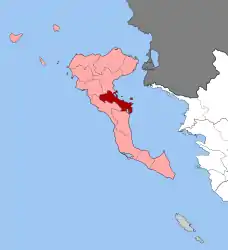 | |
| Coordinates: 39°37′26″N 19°55′17″E | |
| Country | Greece |
| Administrative region | Ionian Islands |
| Regional unit | Corfu |
| Municipality | Central Corfu and Diapontia Islands |
| Government | |
| • Mayor | Merope Hydraiou |
| • Municipal unit | 41.905 km2 (16.180 sq mi) |
| Population (2011)[1] | |
| • Municipal unit | 39,674 |
| • Municipal unit density | 950/km2 (2,500/sq mi) |
| Demonym(s) | Corfiot (Greek: Kerkyreos) |
| Community | |
| • Population | 32,095 (2011) |
| Time zone | UTC+2 (EET) |
| • Summer (DST) | UTC+3 (EEST) |
| Postal code | 49100 |
| Area code(s) | 26610 |
| Vehicle registration | ΚΥ |
| Website | www.corfu.gr |
| Official name | Old Town of Corfu |
| Criteria | Cultural: (iv) |
| Reference | 978 |
| Inscription | 2007 (31st session) |
| Area | 70 ha (170 acres) |
| Buffer zone | 162 ha (400 acres) |
History
The ancient city of Corfu, known as Korkyra, took part in the Battle of Sybota which was a catalyst for the Peloponnesian War, and, according to Thucydides, the largest naval battle between Greek city states until that time. Thucydides also reports that Korkyra was one of the three great naval powers of fifth century BC Greece, along with Athens and Corinth.[3] Medieval castles punctuating strategic locations across the city are a legacy of struggles in the Middle Ages against invasions by pirates and the Ottomans. The city has become known since the Middle Ages as Kastropolis (Castle City) because of its two castles.[4]
From 1386 to 1797, Corfu was ruled by Venetian nobility; much of the city reflects this era when the island belonged to the Republic of Venice, with multi-storied buildings on narrow lanes. The Old Town of Corfu has clear Venetian influence.[5] The city was subjected to four notable sieges in 1537, 1571, 1573 and 1716, in which the strength of the city defenses asserted itself time after time, mainly because of the effectiveness of the powerful Venetian fortifications. Will Durant claimed that Corfu owed to the Republic of Venice the fact that it was the only part of Greece never conquered by the Ottomans.[6]
In 2007, the old town of the city was inscribed on the UNESCO World Heritage List.[7][8][9] The municipal unit of Corfu city has a land area of 41.905 km2 (16.180 sq mi)[10] and a total population of 39,674 inhabitants. Besides the city of Corfu/Kérkyra, its largest other towns are Kanáli (population 4,086), Potamós (3,840), Kontokáli (1,660), Alepoú (3,149), and Gouviá (838).
Palaiopolis
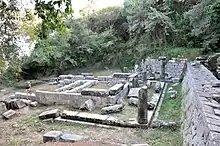
In the city of Corfu, the ruins of the ancient city of Korkyra, also known as Palaiopolis, include ancient temples which were excavated at the location of the palace of Mon Repos, which was built on the ruins of the Palaiopolis. The temples are: Kardaki Temple, Temple of Artemis, and the Temple of Hera. Hera's temple is situated at the western limits of Mon Repos, close to Kardaki Temple and to the northwest.[11] It is approximately 700 m. to the southeast of the Temple of Artemis in Corfu.[11] Hera's Temple was built at the top of Analipsis Hill, and, because of its prominent location, it was highly visible to ships passing close to the waterfront of ancient Korkyra.[11]
Architecture

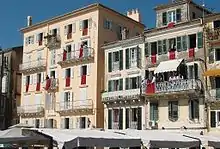
In several parts of the town may be found houses of the Venetian time, with some traces of past splendour. The Palace of St. Michael and St. George, built in 1815 by Sir Thomas Maitland (1759–1824; Lord High Commissioner of the Ionian Islands) is a large structure of white Maltese stone. Near Gasturi stands the Pompeian style Achilleion, the palace built for the Empress Elizabeth of Austria, and purchased in 1907 by the German emperor, William II.
Of the thirty-seven Greek churches the most important are the cathedral, dedicated to Our Lady of the Cave; St. Spiridon's, with the tomb of the patron saint of the island; and the suburban church of St Jason and St Sosipater, reputedly the oldest in the island. The city is the seat of a Greek and a Roman Catholic archbishop; and it possesses a gymnasium, a theatre, an agricultural and industrial society, and a library and museum preserved in the buildings formerly devoted to the university, which was founded by Frederick North, 5th Earl of Guilford (1766–1827, himself the first chancellor in 1824) in 1823, but disestablished on the cessation of the British protectorate.
Based on the ICOMOS evaluation of the old town of Corfu,[8] it was inscribed on the World Heritage List. The ICOMOS experts have noted that "about 70% of the pre-20th century buildings date from the British period" and that "whole blocks were destroyed" in the Old Town by the German World War II blitzes; these were "replaced by new constructions in the 1960s and 1970s". The urban fabric was classified as being predominantly of the Neoclassical period "without special architectural features for which it could be distinguished".[8]
Layout
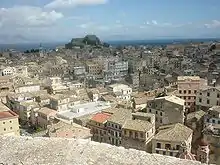

The town of Corfu stands on the broad part of a peninsula, whose termination in the Venetian citadel (Greek: Παλαιό Φρούριο) is cut off from it by an artificial fosse formed in a natural gully, with a salt-water ditch at the bottom, that serves also as a kind of marina known as Contra-Fossa. The old city having grown up within fortifications, where every metre of ground was precious, is a labyrinth of narrow streets paved with cobblestones, sometimes tortuous but mostly pleasant, colourful and sparkling clean. These streets are called "kantounia" (καντούνια) and the older ones sometimes follow the gentle irregularities of the ground while many of them are too narrow for vehicular traffic. There is promenade by the seashore towards the bay of Garitsa (Γαρίτσα), and also an esplanade between the town and the citadel called Liston (Λιστόν) where upscale restaurants and European style bistros abound. The origin of the name Liston has several explanations: many former Venetian cities have a square of that name, coming from a Venetian word meaning evening promenade, but it can also refer to the closed-list aspect of an up-scale area reserved to the nobility registered in the Libro d'Oro.
The citadel was depicted on the reverse of the Greek 500 drachmas banknote of 1983-2001.[12]

Culture
The city of Corfu has a long tradition in the fine arts. The Philharmonic Society of Corfu is part of that tradition. The Museum of the Philharmonic Society of Corfu presents in detail the musical heritage of the island.
Sports
Corfu is the only place in Greece where cricket is popular. It was imported into the island during British rule. The Hellenic Cricket Federation is based in Corfu and it is the only Greek sport federation that is based outside Athens.[13] The most Greek cricket clubs are based in Corfu and they star in the Greek Championship. Notable cricket clubs of Corfu are Kerkyraikos Gymnastikos Syllogos (KGS), founded in 1893, GSK Vyron, founded in 1925 and AO Phaeax founded in 1976.
In other sports, Corfu has two teams with presence in higher divisions. The football club AOK Kerkyra, founded in 1969 originally as "AO Kerkyra", that plays in A Ethniki and the water polo club NAO Kerkyra (NAOK) founded in 1935, with earlier presence in A1 Ethniki Polo.
| Sport clubs based in Ampelokipoi | ||||
|---|---|---|---|---|
| Club | Founded | Sports | Achievements | |
| Kerkyraikos G.S. | 1893 | Basketball, Cricket, Track and Field | Panhellenic titles in Cricket, earlier presence in Beta Ethniki Basketball | |
| GSK Byron | 1925 | Cricket | Panhellenic titles in Cricket, | |
| Olympos Kerkyras | 1934 | Football | Presence in Gamma Ethniki | |
| NAO Kerkyra (NAOK)[14] | 1935 | Water Polo, Swimming | Earlier presence in A1 Ethniki Water Polo | |
| AOK Kerkyra (originally as AO Kerkyra) | 1969 | Football | Presence in A Ethniki | |
| AO Phaeax | 1976 | Basketball, Cricket, Handball | Panhellenic titles in Cricket | |
Climate
Corfu city has a Mediterranean climate. The summers are hot, rainless but humid with temperatures reaching 33 °C (91 °F). The winters are mild and wet, temperatures around on or above 10 °C (50 °F).
| Climate data for Corfu | |||||||||||||
|---|---|---|---|---|---|---|---|---|---|---|---|---|---|
| Month | Jan | Feb | Mar | Apr | May | Jun | Jul | Aug | Sep | Oct | Nov | Dec | Year |
| Record high °C (°F) | 20.5 (68.9) |
22.4 (72.3) |
26.0 (78.8) |
28.0 (82.4) |
33.8 (92.8) |
35.6 (96.1) |
42.4 (108.3) |
40.0 (104.0) |
37.4 (99.3) |
31.0 (87.8) |
25.0 (77.0) |
22.0 (71.6) |
42.4 (108.3) |
| Average high °C (°F) | 13.9 (57.0) |
14.2 (57.6) |
16.0 (60.8) |
19.0 (66.2) |
23.8 (74.8) |
28.0 (82.4) |
30.9 (87.6) |
31.3 (88.3) |
27.6 (81.7) |
23.2 (73.8) |
18.7 (65.7) |
15.3 (59.5) |
21.8 (71.2) |
| Daily mean °C (°F) | 9.7 (49.5) |
10.3 (50.5) |
12.0 (53.6) |
14.9 (58.8) |
19.6 (67.3) |
23.9 (75.0) |
26.4 (79.5) |
26.3 (79.3) |
22.7 (72.9) |
18.4 (65.1) |
14.3 (57.7) |
11.1 (52.0) |
17.5 (63.5) |
| Average low °C (°F) | 5.1 (41.2) |
5.7 (42.3) |
6.8 (44.2) |
9.2 (48.6) |
12.9 (55.2) |
16.4 (61.5) |
18.4 (65.1) |
18.8 (65.8) |
16.5 (61.7) |
13.4 (56.1) |
9.9 (49.8) |
6.8 (44.2) |
11.7 (53.1) |
| Record low °C (°F) | −4.5 (23.9) |
−4.2 (24.4) |
−4.4 (24.1) |
0.0 (32.0) |
4.6 (40.3) |
8.7 (47.7) |
10.0 (50.0) |
11.3 (52.3) |
7.2 (45.0) |
2.8 (37.0) |
−2.2 (28.0) |
−2.0 (28.4) |
−4.5 (23.9) |
| Average rainfall mm (inches) | 136.6 (5.38) |
124.6 (4.91) |
98.1 (3.86) |
66.7 (2.63) |
37.0 (1.46) |
14.1 (0.56) |
9.2 (0.36) |
19.0 (0.75) |
81.3 (3.20) |
137.7 (5.42) |
187.4 (7.38) |
185.6 (7.31) |
1,097.3 (43.20) |
| Average rainy days | 16.1 | 14.6 | 14.5 | 12.9 | 8.0 | 4.9 | 2.3 | 3.4 | 7.0 | 11.8 | 15.7 | 17.5 | 128.7 |
| Average relative humidity (%) | 75.4 | 74.3 | 73.4 | 72.8 | 69.5 | 63.4 | 60.0 | 62.2 | 70.4 | 74.6 | 77.5 | 77.2 | 70.7 |
| Mean monthly sunshine hours | 117.7 | 116.8 | 116.0 | 206.5 | 276.8 | 324.2 | 364.5 | 332.8 | 257.1 | 188.9 | 133.5 | 110.9 | 2,545.7 |
| Source 1: Hellenic National Meteorological Service[15] | |||||||||||||
| Source 2: NOAA (extremes and sun 1961−1990)[16] | |||||||||||||
Government
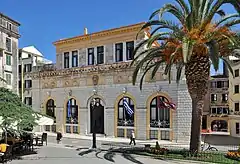
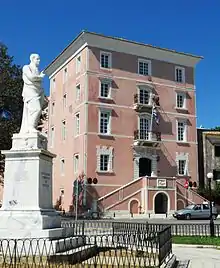
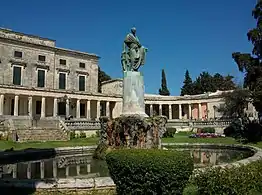
Mayor history
Up until 1866, Corfu had no mayors. This list starts from 1866 and on.[17]
- Nikolaos V. Manesis (1866–1870)
- Christodoulos M. Kiriakis (1870–1879)
- Georgios Theotokis (1879–1885)
- Ioannis Padovas (1885-1887)[18]
- Michael Theotokis (1887–1895)
- Angelos Psoroulas (1895–1899)
- Dimitrios Kollas (1899–1911)
- Ioannis Mavrogiannis (1914–1925)
- Spyridon Kollas (1925–1951)
- Stamatios Desyllas (1951–1955)[19]
- Maria Desylla-Kapodistria (1956–1959), first female mayor in Greece.[19]
- Panagiotis Zafiropoulos (1959–1964)
- Spyros Rath (1964–1967)
- Municipal councils (1967–74)
- Konstantinos Alexopoulos (1974–1975)
- Spyros Rath (1975–1978)
- Ioannis Kourkoulos (1979–1990)
- Chrisanthos Sarlis (1991–2002)
- Alexandros Mastoras (2003–2006)
- Sotirios Micallef (2007–2010)
- Ioannis Trepeklis (2011–2014)
- Kostas Nikolouzos (2014–19)[20]
- Merope Hydraiou (2019–)
International relations
Twin towns - sister cities
Corfu is twinned with:[21][22][23][24][25]
 Kruševac, Serbia (1985)
Kruševac, Serbia (1985)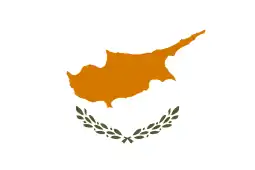 Paphos, Cyprus (1992)
Paphos, Cyprus (1992) Famagusta, Cyprus (1994)
Famagusta, Cyprus (1994) Meissen, Germany (1996)
Meissen, Germany (1996) Troisdorf, Germany (1996)
Troisdorf, Germany (1996) Asha, Cyprus (1998)
Asha, Cyprus (1998) Brindisi, Italy (1998)
Brindisi, Italy (1998) Vathy, Greece (1998)
Vathy, Greece (1998) Carovigno, Italy (2000)
Carovigno, Italy (2000) Koper, Slovenia (2000)
Koper, Slovenia (2000) Sarandë, Albania (2001)
Sarandë, Albania (2001) Tremetousia, Cyprus (2001)
Tremetousia, Cyprus (2001) Ioannina, Greece (2002)
Ioannina, Greece (2002) Bethlehem, United States (2013)
Bethlehem, United States (2013) Bar, Montenegro (2017)
Bar, Montenegro (2017) Bari, Italy
Bari, Italy Zemun (Belgrade), Serbia
Zemun (Belgrade), Serbia Mytilene, Greece
Mytilene, Greece
Consulates
The city hosts consulates from the following countries:
 Austria
Austria.svg.png.webp) Belgium
Belgium Denmark
Denmark France
France Germany
Germany Hungary
Hungary Italy
Italy Netherlands
Netherlands Norway
Norway Portugal
Portugal Russia
Russia Sweden
Sweden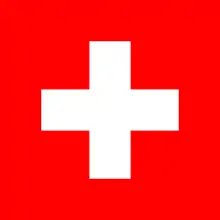 Switzerland
Switzerland Serbia
Serbia Spain
Spain United Kingdom
United Kingdom
Quarters
|
|
Main streets
|
|
Media
- TV: Corfu TV, Start TV
- Newspapers: Kerkyra Simera
Gallery
 Old depiction of Corfu, 1487
Old depiction of Corfu, 1487 Belltower of the Saint Spyridon Church, patron saint of the city
Belltower of the Saint Spyridon Church, patron saint of the city Panagia Mandrakina
Panagia Mandrakina Saint George Temple at the Old Fortress
Saint George Temple at the Old Fortress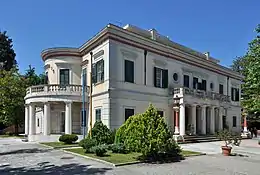
 Achilleion façade
Achilleion façade Carnival in Kerkyra by Charalambos Pachis
Carnival in Kerkyra by Charalambos Pachis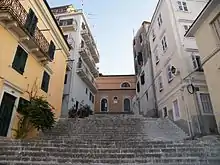
 Belltower of Annunziata/Lontsiada Catholic church (Evangelistria)
Belltower of Annunziata/Lontsiada Catholic church (Evangelistria)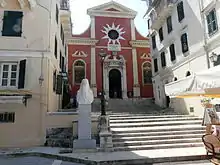 Panagia Spiliotissa Cathedral
Panagia Spiliotissa Cathedral
See also
References
 This article incorporates text from a publication now in the public domain: Chisholm, Hugh, ed. (1911). "Corfu". Encyclopædia Britannica. 7 (11th ed.). Cambridge University Press. pp. 145–146.
This article incorporates text from a publication now in the public domain: Chisholm, Hugh, ed. (1911). "Corfu". Encyclopædia Britannica. 7 (11th ed.). Cambridge University Press. pp. 145–146.
- "Απογραφή Πληθυσμού - Κατοικιών 2011. ΜΟΝΙΜΟΣ Πληθυσμός" (in Greek). Hellenic Statistical Authority.
- Kallikratis law Greece Ministry of Interior (in Greek)
- Thucydides, History of the Peloponnesian War 1.36.3
- "Home Page". Municipality of Corfu. Archived from the original on 2017-07-04. Retrieved 2010-03-23.
- Italian Corfu city
- Will Durant. The Renaissance. page 684. MJF Books. New York, 1981 ISBN 1-56731-016-8
- BBC news on UNESCO World Heritage list
- UNESCO Advisory Body (ICOMOS) report on Corfu History retrieved 3 July 2007
- Old Town of Corfu on UNESCO website retrieved 3 July 2007
- "Population & housing census 2001 (incl. area and average elevation)" (PDF) (in Greek). National Statistical Service of Greece. Archived from the original (PDF) on 2015-09-21.
- Philip Sapirstein (2012). "The Monumental Archaic Roof of the Temple of Hera at Mon Repos, Corfu". Hesperia: The Journal of the American School of Classical Studies at Athens. 81 (1): 31–91. doi:10.2972/hesperia.81.1.0031. JSTOR 10.2972/hesperia.81.1.0031.
- Bank of Greece Archived March 28, 2009, at the Wayback Machine. Drachma Banknotes & Coins: 500 drachmas Archived 2007-10-05 at the Wayback Machine. – Retrieved on 27 March 2009.
- "History". cricket.gr. Retrieved 17 April 2015.
- "NAOK website". naok.gr/. NAOK.
- "Mean Corfu Climatic Averages". Hellenic National Meteorological Service. Archived from the original on 24 January 2015. Retrieved 1 March 2015.
- "Kekira Climate Normals 1961–1990". National Oceanic and Atmospheric Administration. Retrieved 1 March 2015.
- "History of City Councils from the Municipality of Corfu". Municipality of Corfu. 2005-09-20. Archived from the original on April 9, 2005. Retrieved 2007-03-30.
- "Municipal council of Corfu, 5th period (1883-1887)". Retrieved 17 September 2014.
- Municipality of Corfu from the Internet archive Quote:In the elections of 1954 Stamatios Desillas was elected Mayor for a second term and remained in office until his death, Christmas Day 1955. Soon after a bye-election took place in Corfu in which the widow of the deceased Maria Desilla - Kapodistria, was elected Mayor with 5,365 votes in a total of 10,207. Maria Desilla became Mayor of Corfu on 15 April 1956 until 9 May 1959. She was the first female Mayor in Greece.
- "Mayor of Corfu". corfu.gr.
- "Αδελφοποιήσεις Δήμου". corfu.gr (in Greek). Kerkyra. Retrieved 2020-01-10.
- "Sister Cities". bethlehem-pa.gov. City of Bethlehem. Retrieved 2020-01-10.
- "Gradovi pobratimi". bar.me (in Montenegrin). Bar. Retrieved 2020-01-10.
- "MV-U-7/19: KD Okvirni sporazum putovanja". zemun.rs (in Serbian). Zemun. 2019-06-01. p. 7. Retrieved 2020-01-10.
- "Αδελφοποιημένες Πόλεις". mytilene.gr (in Greek). Mytilene. Retrieved 2020-01-10.
External links
| Wikimedia Commons has media related to Corfu town. |
 Corfu Town travel guide from Wikivoyage
Corfu Town travel guide from Wikivoyage- Municipal website
